 |
 |
 |
 |
 |
 |
 |
 |
 |
 |
 |
 |
 |
 |
|
 Louvetot
2
Louvetot
2 |
 Visages Visages
|
|
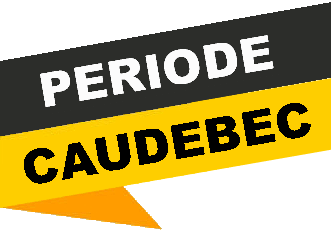
La période Caudebec-en-Caux
En service du
mardi 13 décembre 1938 au jeudi 7* septembre 1939
* en fait le vendredi 8 septembre (fin définitive des émissions à 1.00 du matin)
In service from Tuesday, December 13, 1938 to Thursday, September 7,
1939
|
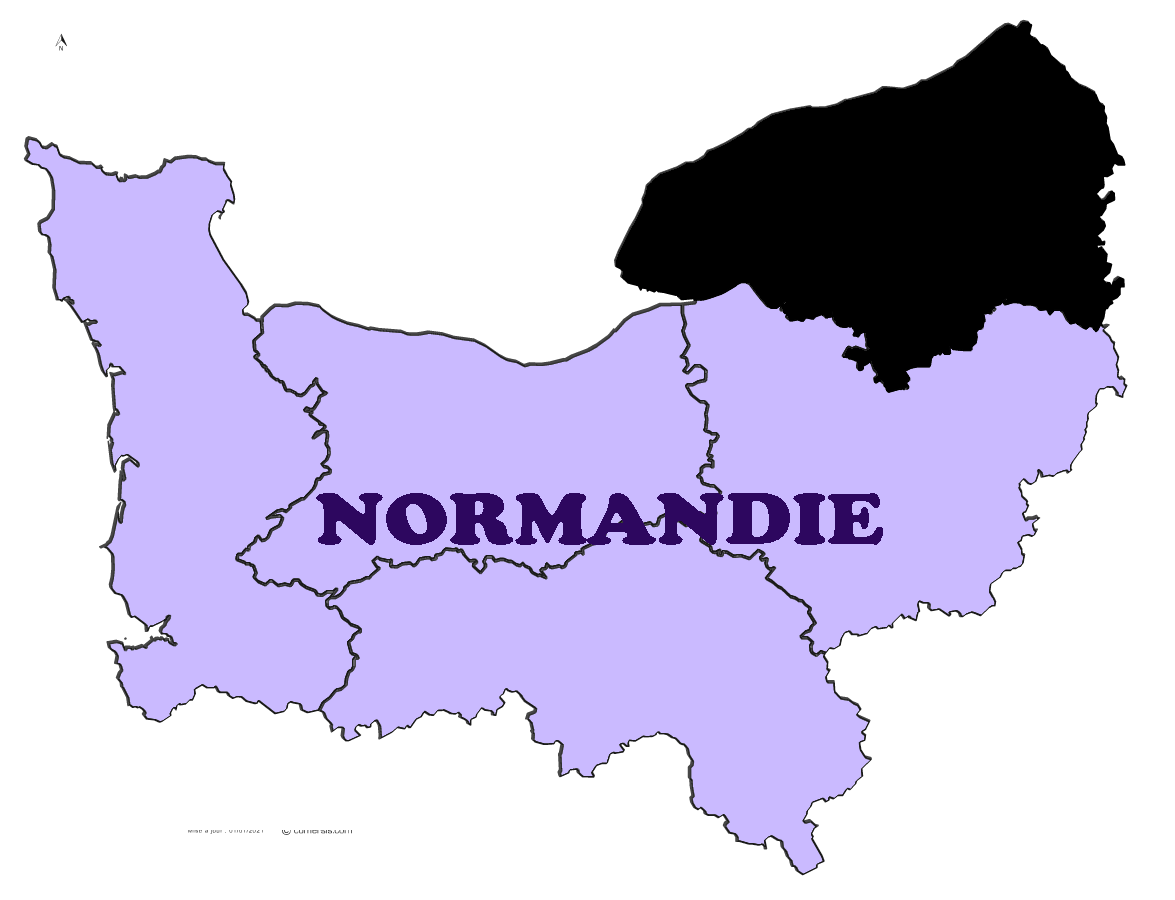 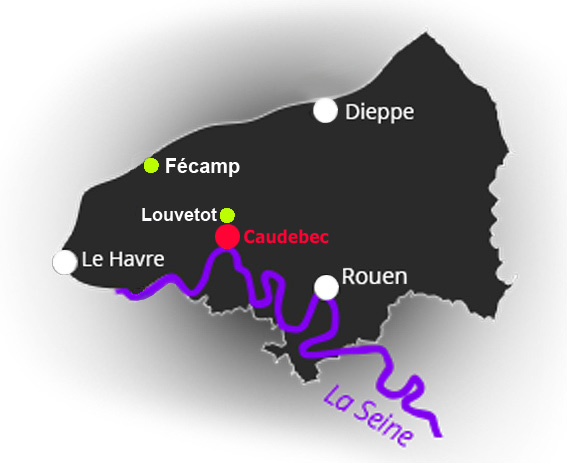
Seine-Maritime
anct "Seine-Inférieure"
|
|
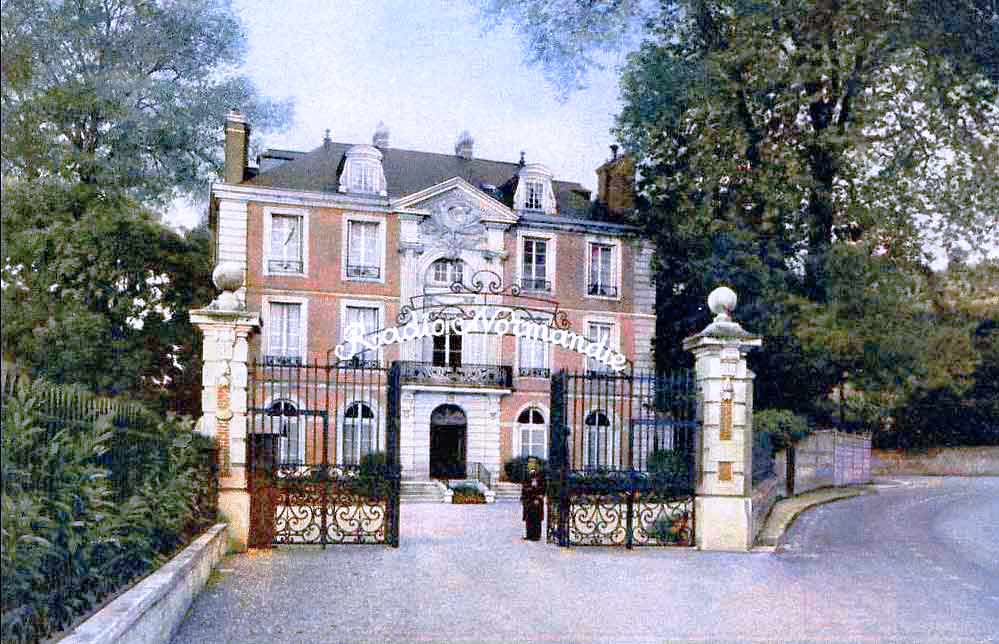 |
Le château de Caumont au bord de la Seine à Caudebec-en-Caux, le
nouveau siège social de Radio Normandie. Voici l'entrée des studios. Ceux-ci ont été utilisés très peu de temps du 12 décembre 1938 au 7 septembre 1939. A dr., la route menant vers Villequier. Remarquez le gardien en uniforme et képi, posté près de la grille qui pourrait être Monsieur Malandain ou M. Albert Berthelot. Du château part le câble coaxial souterrain reliant
l'émetteur de Louvetot, à 6 kilomètres plus au Nord. Le câble traverse la Forêt de Maulévrier et contient plusieurs lignes téléphoniques.
Caumont Castle on the
banks of the Seine in Caudebec-en-Caux, the new headquarters of
Radio Normandie. This is the entrance to the studios. These were
used for a very short time from December 12, 1938 to September 7,
1939. On the right, the road leading to Villequier. Note the guard
in uniform and cap, posted near the gate, who could be Mr. Malandain
or Mr. Albert Berthelot. From the castle runs the underground
coaxial cable connecting the transmitter at Louvetot, 6 kilometers
further north. The cable crosses the Maulévrier Forest and contains
several telephone lines. |
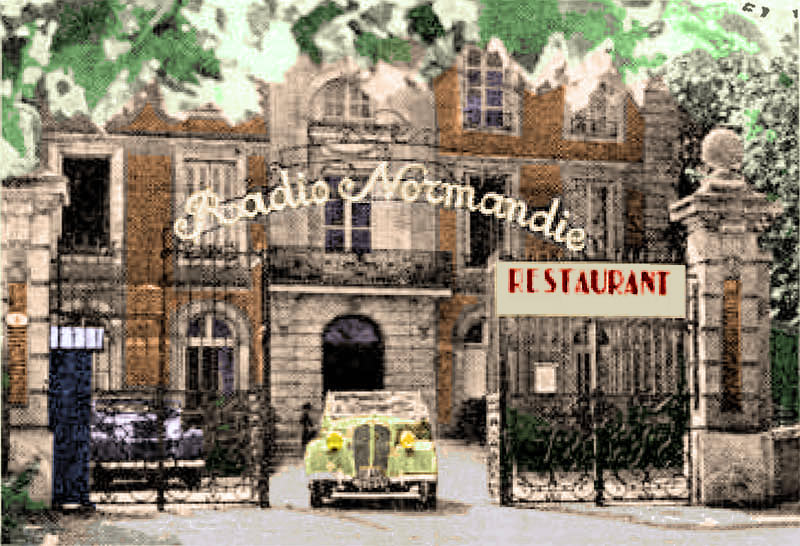
Au rez-de-chaussée, il
y avait aussi un restaurant
dont certains visiteurs le recommandait
comme très bon - et certainement le meilleur de l'endroit
!
On the ground floor,
there was also a restaurant that some visitors recommended
as very good—and certainly the best in the area! |

Listeners,
Tourists,
Visit Caudebec-en-Caux
and its magnificent castle
headquarters of
Radio-Normandie
In the restaurant or under the pergola, on the banks
of the Seine, you can have lunch or dinner.
At the bar, all aperitifs and cocktails will be served
to you by Mr. Elie, manager of the Bar-restaurant.
Fixed price 18 francs or to order. (=11 € - £ 9,23)
Telephone 72 in Caudebec-en-Caux.
Being a member of the "Radio-Normandie" listeners'
association entitles you to a reduction of 2 francs per
membership card, on the price of the meal.
|
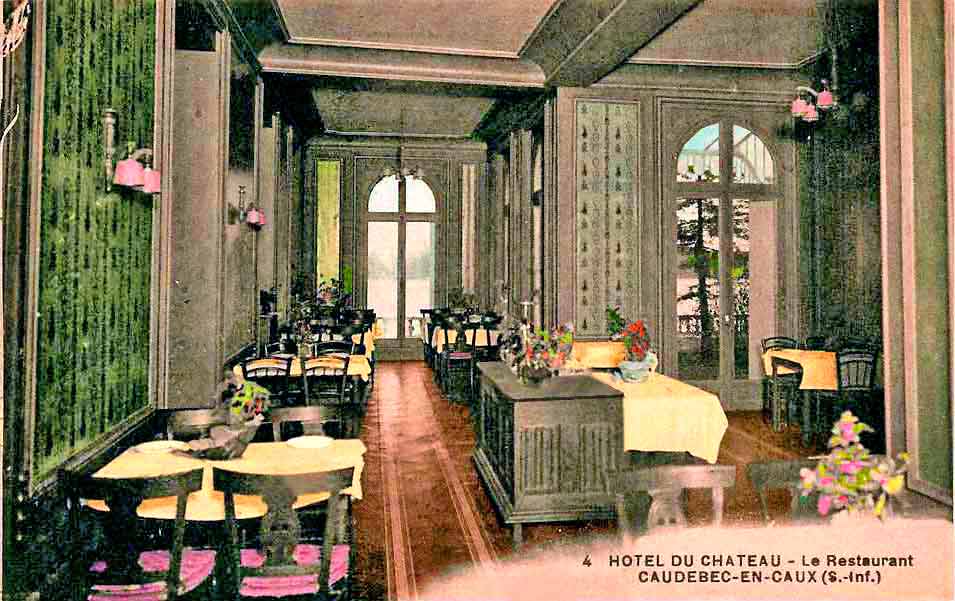
La salle du restaurant
The restaurant room
|
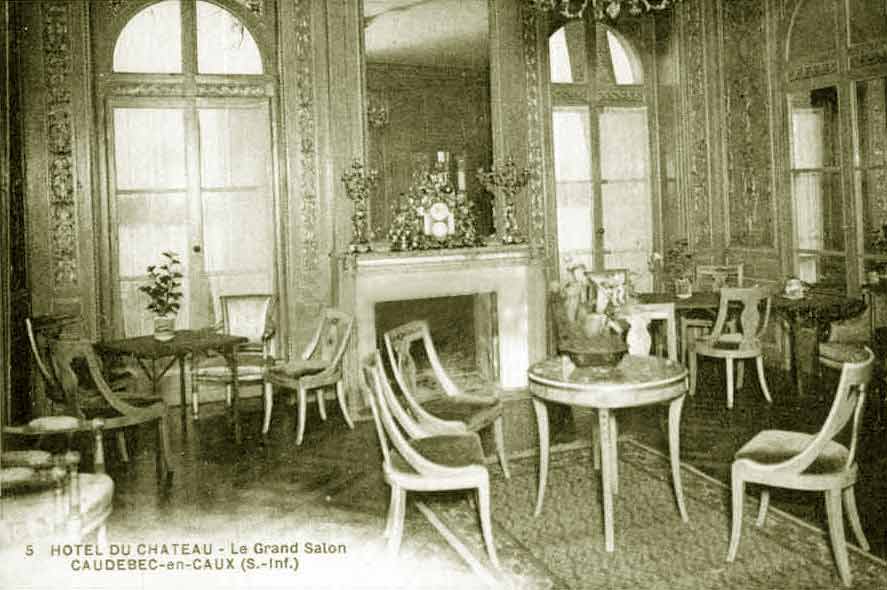
Le grand salon appelé aussi "Salon doré"
The large living room also called “Golden Living Room” |
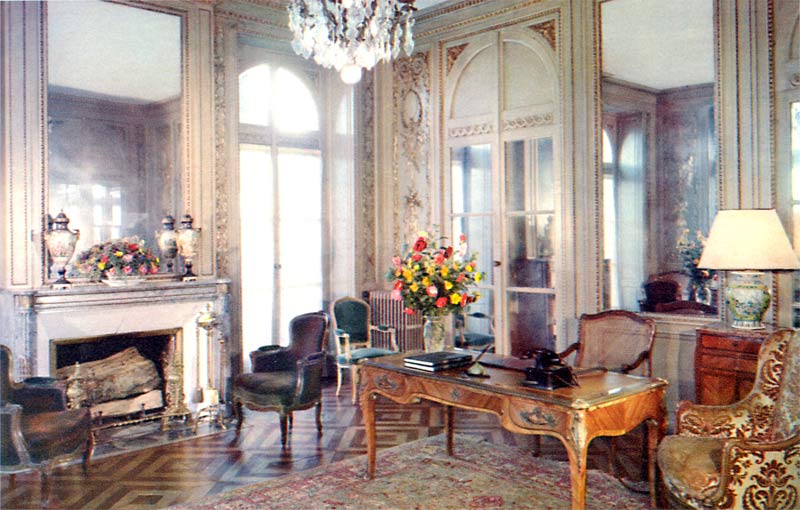
Le même grand salon ou "salon doré" en 1938, pour la réception des visiteurs au rez-de-chaussée
The same "golden salon" in 1938, for reception of visitors on the ground floor

En 2010 : le salon est devenu le bureau de Monsieur le Maire de Caudebec-en-Caux.
Si le parquet est toujours le même, seul le mobilier a changé.
In 2010 : the salon became the office of the Mayor of Caudebec-en-Caux.
If the floor is still the same, only the furniture has changed.

Quant à l'écran plat sur le bureau... pas de doute, nous sommes bien en 2010 !
As for the flat screen on the desktop... no doubt, it’s 2010 !
Les 2 photos ci-dessus ont été prises en 2010 à l'occasion des Journées du Patrimoine < autres photos à retrouver
|
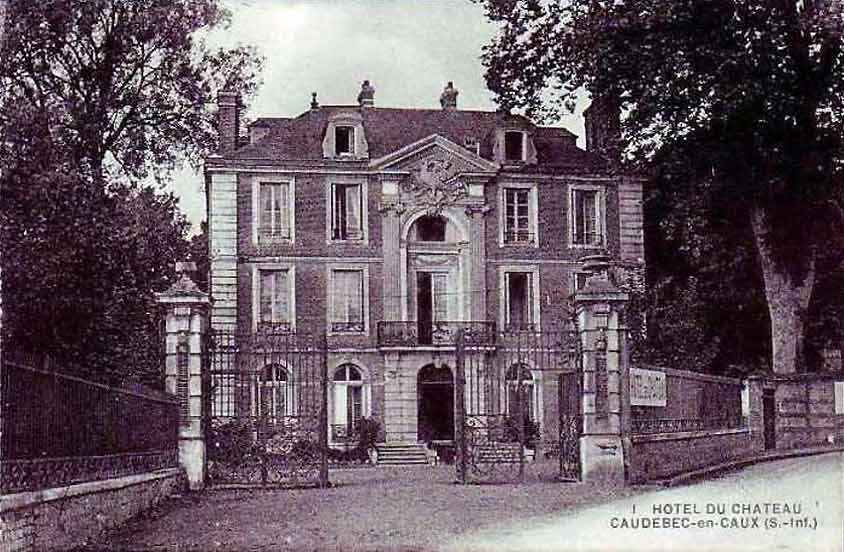
Au premier étage et une partie du second, ce sont les bureaux administratifs, une discothèque et les studios
pour les émissions françaises. Le dernier étage est réservé aux appartements du personnel technique
et les speakers français. Les présentateurs anglais logeaient dans les hôtels de Caudebec
The first floor and part of the second floor house administrative offices, a discotheque and studios
for French programmes. The top floor is reserved for the flats of the technical staff
and the French announcers. English announcers stayed in hotels in Caudebec
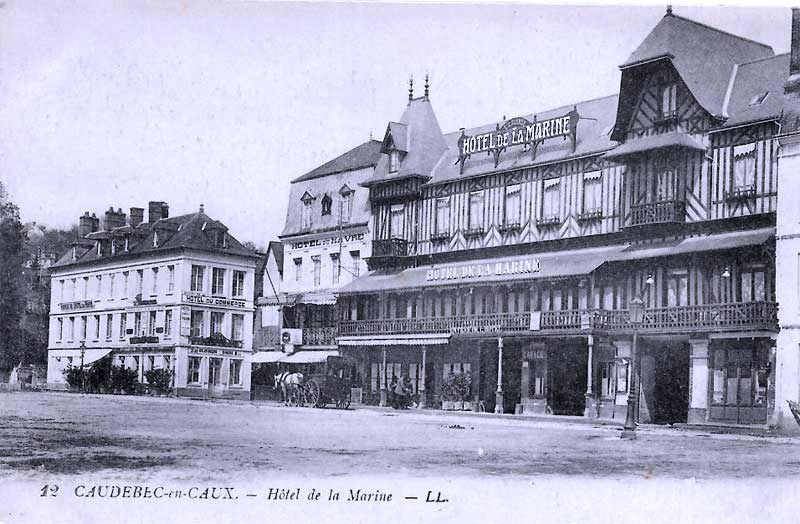
L'Hôtel de Normandie et l'Hôtel de la Marine à Caudebec où ont séjourné
les speakers britanniques de la station
The Hôtel de Normandie and the Hôtel de la Marine in Caudebec
where the station's British speakers stayed
|
Suite de l'extrait de l'annuaire des cinq départements
de la Normandie publié par l'Association Normande |
suite du chapitre Louvetot
(...) "Le château de Caudebec est un véritable bijou d'un style très pur construit sur les bords de la Seine et entouré d'un parc magnifique.
Quand il fut acheté par Radio-Normandie, ce château avait été transformé en hôtellerie. Le bar-restaurant est resté aménagé alors que les étages supérieurs ont été transformés en bureaux et studios. Dans le fond du parc, à côté des garages, se trouvent des studios de secours. Ndw : ces studios étaient utilisés pour les émissions anglaises
L'installation du poste de Radio-Normandie à Caudebec-Louvetot est une installation unique tant au point de vue technique qu'au point de vue artistique. L'accueil qui y fut réservé aux nombreux membres de l'Association Normande fut cordial et bien dans la tradition de la famille de M. Fernand Legrand, Président du Conseil d'Administration de l'Association des Auditeurs de Radio-Normandie auquel l'Association Normande adresse ses plus vifs remerciements".
Source: gallica.bnf.fr / Bibliothèque nationale de France, département Collections numérisées, 2008-115088 | continuation of the previous chapter
(...) "The Château de Caudebec is a true jewel of a very pure style built on the banks of the Seine and surrounded by a magnificent park.
When it was bought by Radio-Normandy, this castle had been transformed into a hotel. The bar-restaurant has remained furnished while the upper floors have been transformed into offices and studios. At the end of the park, next to the garages, there are emergency studios. Ndw: these studios were used for English broadcasts
The installation of the Radio-Normandy station in Caudebec-Louvetot is a unique installation from both a technical and artistic point of view.
The welcome extended to the many members of the Association Normande was cordial and well in the tradition of the family of Mr. Fernand Legrand, Chairman of the Board of Directors of the Radio Normandy Listeners Association to whom the Association Normande sends its warmest thanks ".
National Library of France |
|
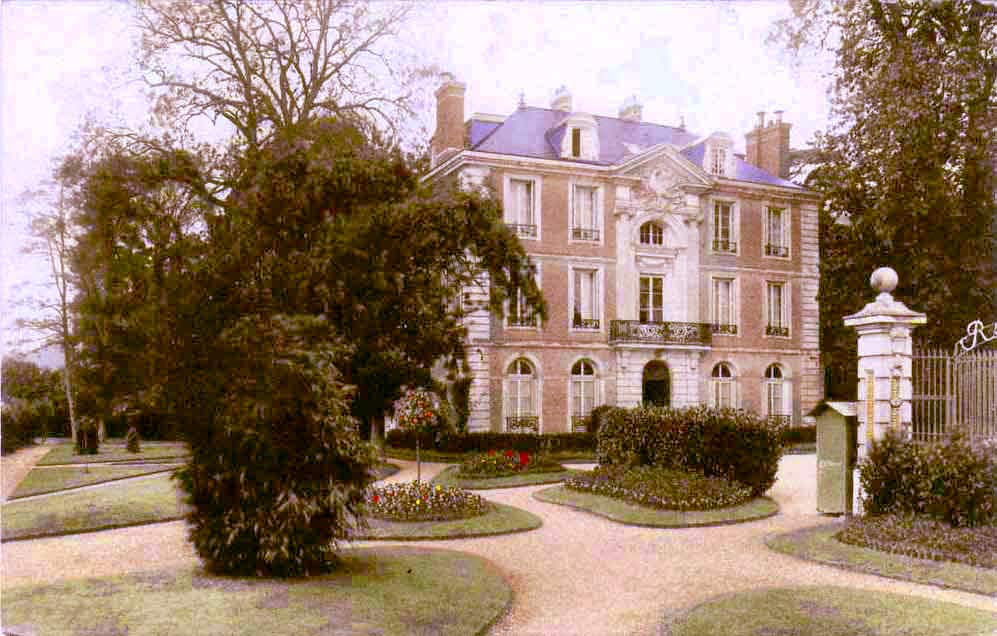
Le calme du parc avant-guerre, idéal pour réaliser des émissions de radio.
Les studios anglais se trouvaient dans des dépendances au fond du parc
The calm of the pre-war park, ideal for making radio broadcasts.
The English studios were located in outbuildings at the back of the park
|
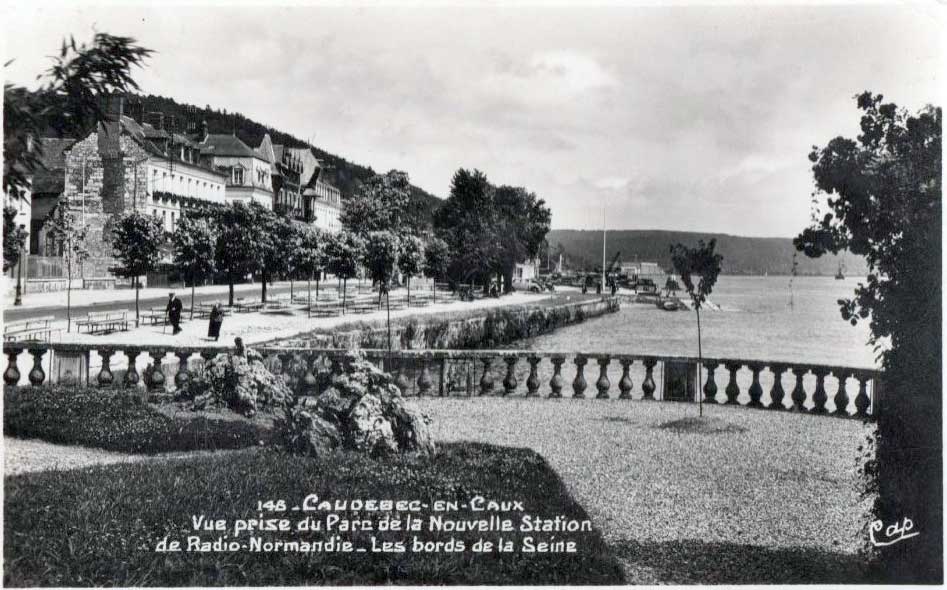
Caudebec-en-Caux au bord de la Seine
View taken from the grounds of the new radio station. The banks of the Seine
|
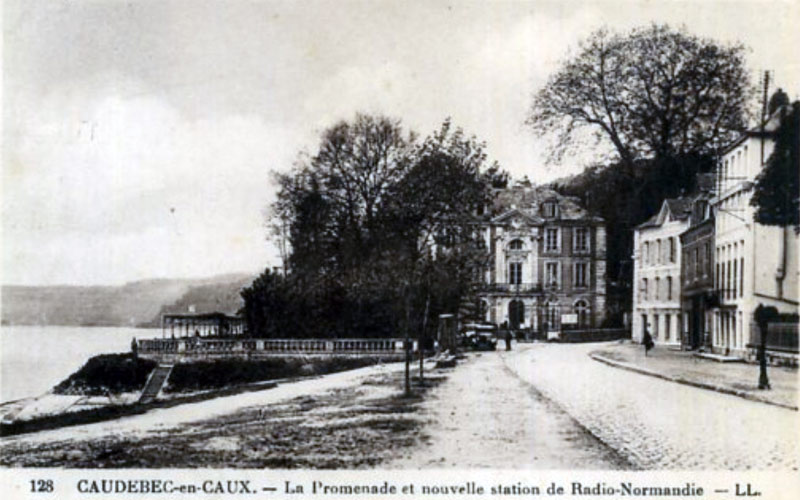
Caudebec-en-Caux - The promenade and new Radio-Normandie station
|
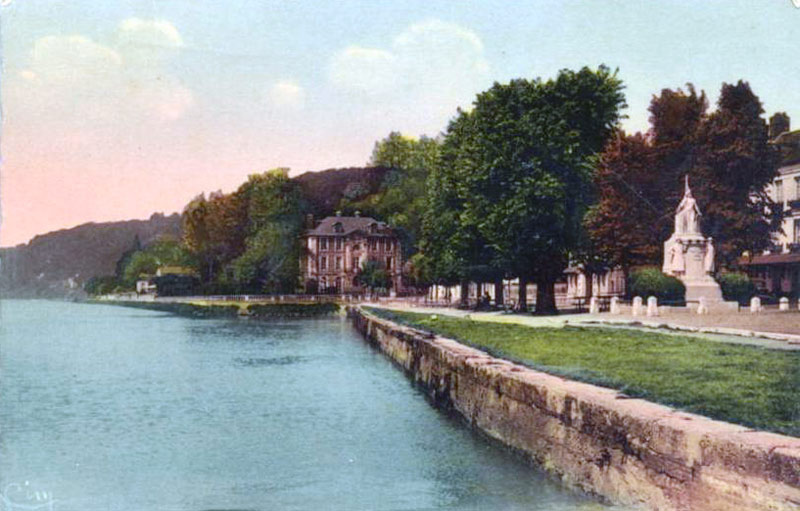
|
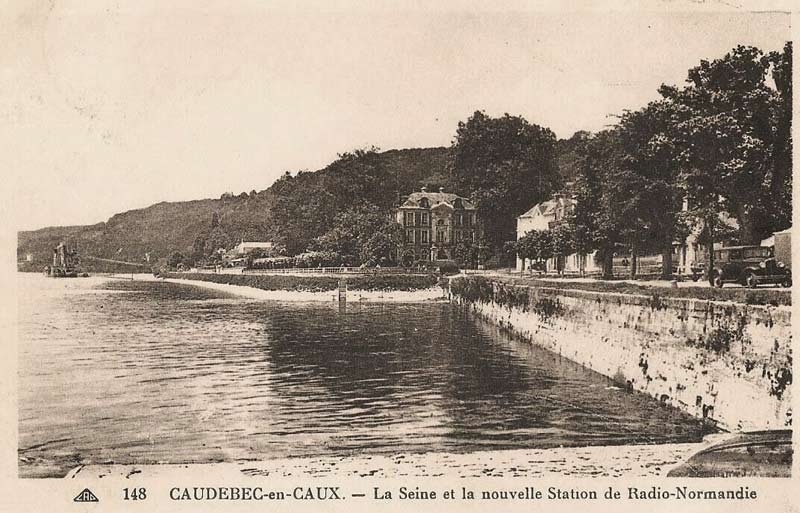
|
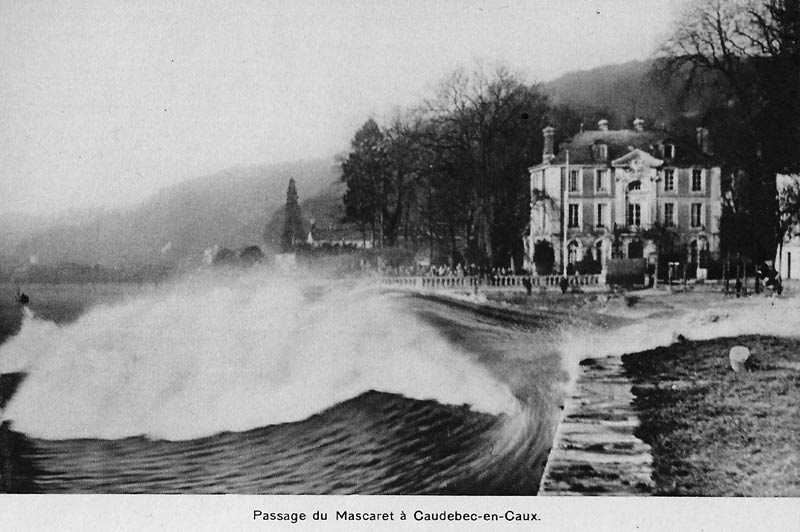
Passage of the tidal bore, a major attraction of the time
|
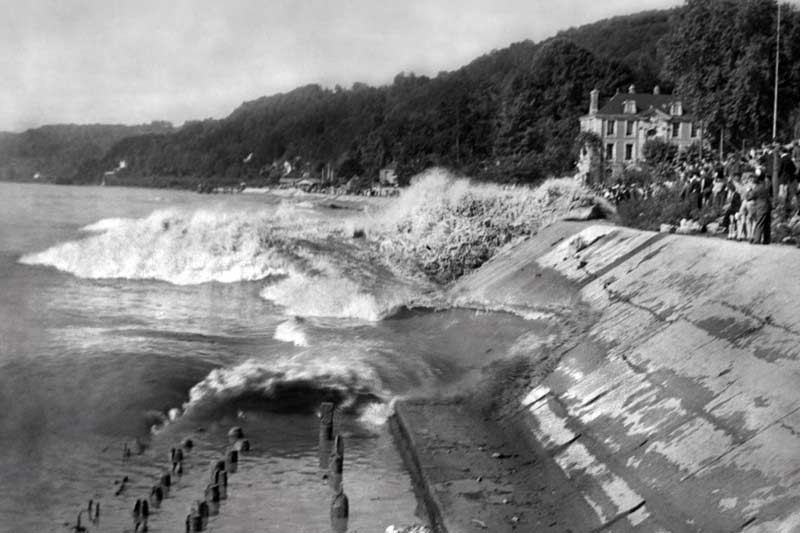
|
Le mascaret
est une vague sur la Seine qui se propage vers l'amont lors
des grandes marées. Ce phénomène très marqué jusque dans les
années 1960, a été atténué par les travaux d'aménagement de
l'estuaire. Le phénomène est dû à la rencontre de la marée
montante et du courant descendant. Il est renforcé par la
faible pente du fleuve. Pendant des siècles, les riverains
se méfiaient de lui, mais il attirait les curieux.
La vague pouvait atteindre une hauteur de 2,5 mètres. Le
point culminant était Caudebec-en-Caux. La vague se
dissipait aux alentours de Duclair.
The tidal bore is a wave on
the Seine that propagates upstream during high tides. This
phenomenon, which was very pronounced until the 1960s, has
been mitigated by development work in the estuary. The
phenomenon is due to the meeting of the rising tide and the
falling current. It is reinforced by the river's gentle
gradient. For centuries, local residents were wary of it,
but it attracted the curious.
The wave could reach a height of 2.5 metres. The highest
point was Caudebec-en-Caux. The wave dissipated around
Duclair. |
|
Le mascaret à Caudebec
dans les années 20
|
|
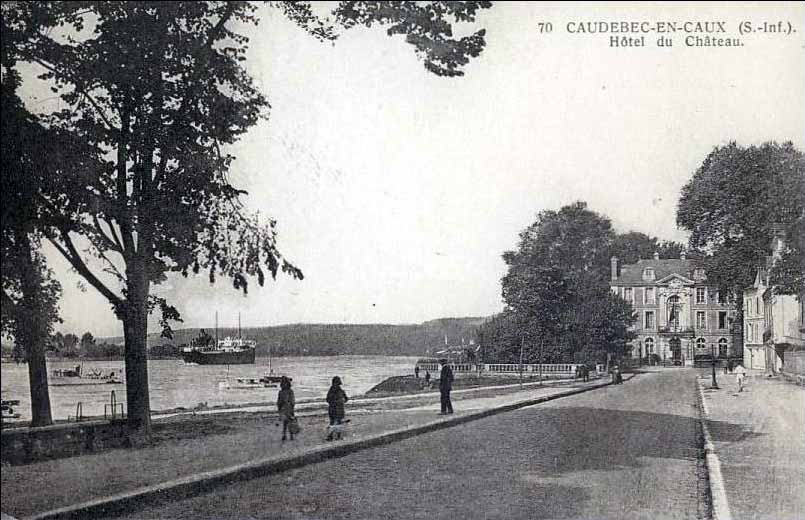 |
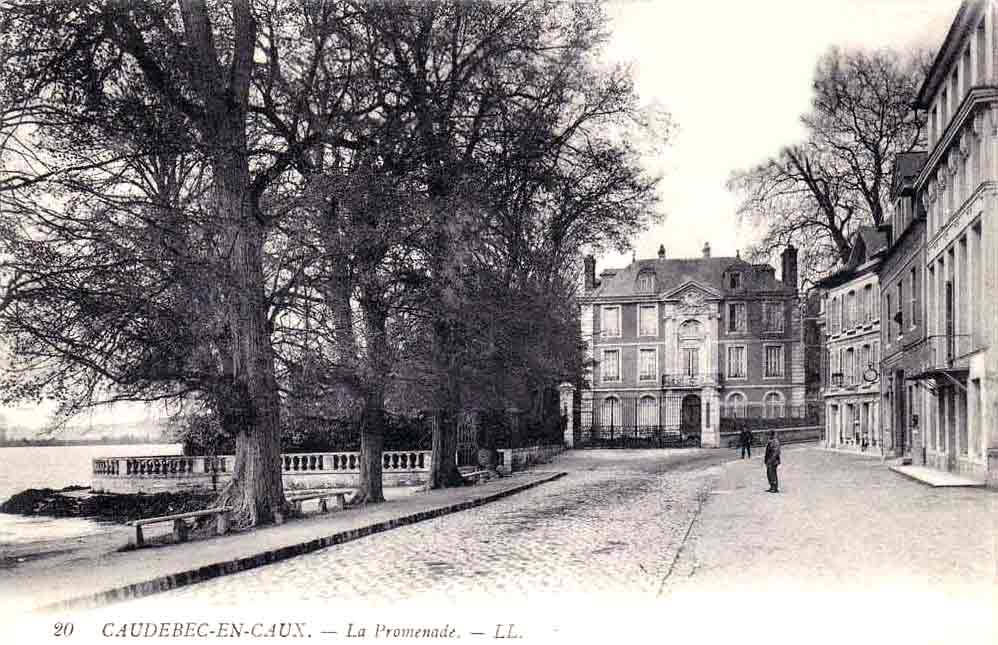
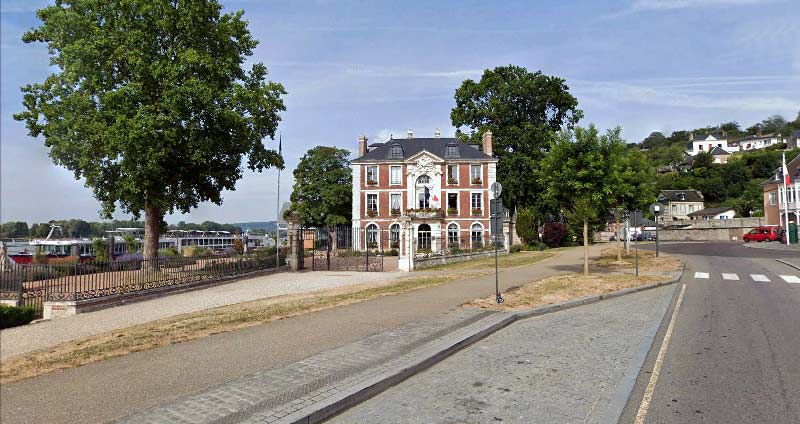
Changement d'époque : les hôtels à droite ont disparu, la promenade s'est élargie,
il y a beaucoup moins d'arbres mais le château de Caudebec au passé prestigieux a été préservé des bombardements
Change of era: the hotels on the right have disappeared, the promenade has widened,
there are far fewer trees but the Caudebec castle with its prestigious past has been preserved from the bombings
|
Un espion de la BBC
à Caudebec et
à Louvetot
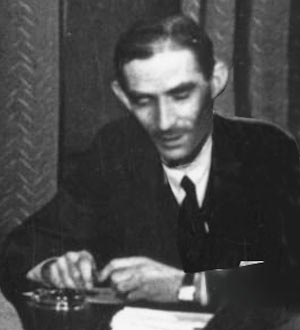 Au cours de l'été 1937, Maurice Farquharson (contrôleur - relations publiques à la BBC), en vacances en Normandie, constate l'ampleur des investissements rendus possibles par la montée en puissance financière des radios commerciales sur le continent. En traversant la petite ville de Caudebec-en-Caux, il tombe sur le nouveau siège, pas encore opérationnel, de Radio Normandie. À cette époque, la station fonctionne encore dans ses studios exigus de Fécamp. En revanche, les nouveaux locaux dévoilent une grande opulence, puisqu'il s'agit d'un très beau petit château d'époque, peut-être du début du XVIIIe siècle, situé dans un délicieux jardin au bord de la Seine. Farquharson a pu accéder au bâtiment, sans doute parce qu'une grande partie est ouverte au public, notamment un restaurant. Les studios, a-t-il observé, se trouvent aux premier et dernier étages, et la seule indication extérieure de la destination du bâtiment en tant que centre de radiodiffusion est fournie par les mots "Radio Normandie" en lettres dorées sur le portail d'entrée. Il a recommandé le restaurant comme étant très bon - presque certainement le meilleur de l'endroit, Au cours de l'été 1937, Maurice Farquharson (contrôleur - relations publiques à la BBC), en vacances en Normandie, constate l'ampleur des investissements rendus possibles par la montée en puissance financière des radios commerciales sur le continent. En traversant la petite ville de Caudebec-en-Caux, il tombe sur le nouveau siège, pas encore opérationnel, de Radio Normandie. À cette époque, la station fonctionne encore dans ses studios exigus de Fécamp. En revanche, les nouveaux locaux dévoilent une grande opulence, puisqu'il s'agit d'un très beau petit château d'époque, peut-être du début du XVIIIe siècle, situé dans un délicieux jardin au bord de la Seine. Farquharson a pu accéder au bâtiment, sans doute parce qu'une grande partie est ouverte au public, notamment un restaurant. Les studios, a-t-il observé, se trouvent aux premier et dernier étages, et la seule indication extérieure de la destination du bâtiment en tant que centre de radiodiffusion est fournie par les mots "Radio Normandie" en lettres dorées sur le portail d'entrée. Il a recommandé le restaurant comme étant très bon - presque certainement le meilleur de l'endroit,
et ceci, du fait que Caudebec est noté comme un lieu de beauté, très populaire auprès des visiteurs. Ce n'est qu'en poussant plus loin ses investigations qu'il s'aperçoit que les locaux du Château ne sont réservés qu’aux émissions françaises... |
A BBC spy
in Caudebec and Louvetot
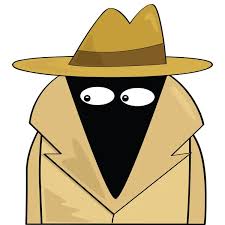 That summer of 1937, Maurice Farquharson (BBC controller and public relations dept), on holiday in Normandy, had received a graphic illustration of the extent of investment that had become possible as Continental Commercial Radio gained in financial stature. Traveling through the small town of Caudebec-en-Caux, he came across the new headquarters, not yet opened, of Radio Normandy. At this point, the station was still operating from its original cramped studios in Fecamp. The new premises represented considerable opulence in contrast, consisting as they did of "an extremely beautiful little period chateau, perhaps early eighteenth century, situated in a delightful garden on the river bank of the Seine. "Farquharson was able to gain access to the building, presumably because much of it was open to the public, including a restaurant. The studios, he observed, were on the "first and upper storeys", and "the only outward indication of the building's purpose as a broadcasting center is provided by the words "Radio Normandie" in gilt letters on the entrance gateway. " He was able to recommend the restaurant as "very good - almost certainly the best in the place", and this, together with the fact that Caudebec was noted as a beauty spot, very popular with visitors "will no doubt in themselves bring the company a certain amount of goodwill. " It was only when he explored further that he realized that the Chateau premises were only for the French native broadcasts... That summer of 1937, Maurice Farquharson (BBC controller and public relations dept), on holiday in Normandy, had received a graphic illustration of the extent of investment that had become possible as Continental Commercial Radio gained in financial stature. Traveling through the small town of Caudebec-en-Caux, he came across the new headquarters, not yet opened, of Radio Normandy. At this point, the station was still operating from its original cramped studios in Fecamp. The new premises represented considerable opulence in contrast, consisting as they did of "an extremely beautiful little period chateau, perhaps early eighteenth century, situated in a delightful garden on the river bank of the Seine. "Farquharson was able to gain access to the building, presumably because much of it was open to the public, including a restaurant. The studios, he observed, were on the "first and upper storeys", and "the only outward indication of the building's purpose as a broadcasting center is provided by the words "Radio Normandie" in gilt letters on the entrance gateway. " He was able to recommend the restaurant as "very good - almost certainly the best in the place", and this, together with the fact that Caudebec was noted as a beauty spot, very popular with visitors "will no doubt in themselves bring the company a certain amount of goodwill. " It was only when he explored further that he realized that the Chateau premises were only for the French native broadcasts...
|
|
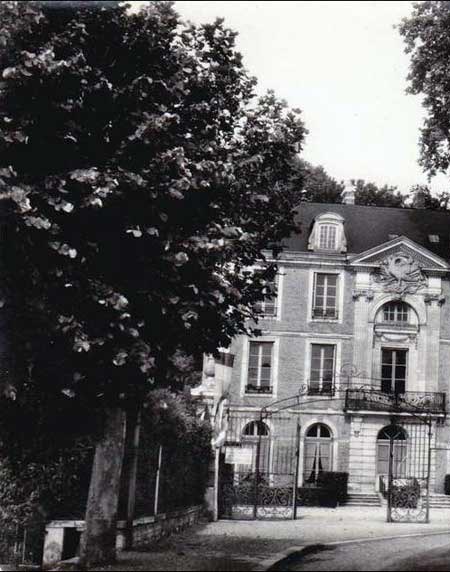
Le "Château
de Caumont", siège de Radio Normandie.
|
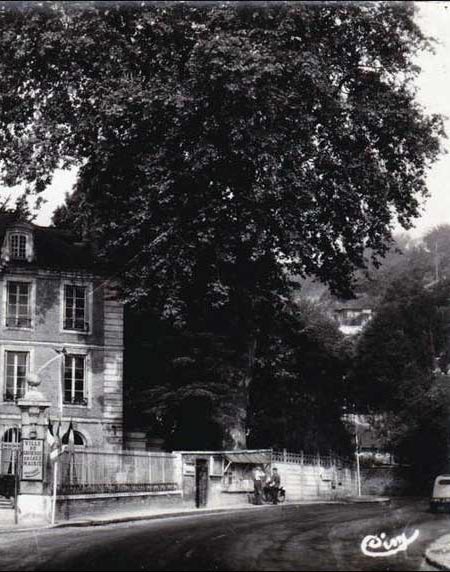
à Caudebec entre
1938 et 1939 (vue prise en 1942)
|
|
... Jusqu'alors, les transmissions en anglais de Radio Normandie étaient limitées par le fait que les installations devaient être partagées avec les français. Avec la popularité croissante dès le milieu des années 1930, un nouvel arrangement devait être trouvé, le château et les terrains de Caudebec ont fourni la réponse. En contraste direct avec l'opulence du château, Farquharson découvre les studios anglais de l'IBC au fond du parc dans un garage avec deux ou trois pièces adjacentes. Ces studios de plain-pied sont recouverts de tôle ondulée et sont autrement peu impressionnants. Après avoir obtenu la permission d'y jeter un coup d'œil, il constate que, aussi utilitaires soient-elles, ces installations répondent à toutes les exigences de base d'une station de radio :
I) Un petit studio avec six platines de gramophone et un microphone pour l'annonceur (il y a deux annonceurs) ;
2) une bibliothèque de disques de gramophone (pas encore classés, mais avec d'importants colis de disques sur le point d’être déballés), et
3) une pièce pour les appareils, les accumulateurs, etc.
Farquharson estime que l'insonorisation est insuffisante mais d'un autre côté, il comprend ici qu’il n'y aura évidemment pas d'interviews d’artistes en “live” à prendre en considération.
Non loin de là, à Louvetot, à
six kilomètres environ sur la route d'Yvetot, se trouve le nouvel émetteur de Radio Normandie, qui n'est pas encore en service, mais qui va représenter une augmentation importante de la puissance de la station. Ce qu'il ne mentionne pas, et ne sait probablement pas, c'est que l'acquisition et le développement du site de Caudebec ont représenté plus de deux années de travaux de la part de l'IBC et de leurs propriétaires normands ; ces locaux - anciennement "L'Hôtel du Château", avaient été acquis à l'origine en 1935, et la rénovation principale qu'il a vue, est le résultat de ces années ainsi qu'un investissement très confiant.
Extrait de
"Crossing the Ether" par Sean Street (p. 171 et 172) |
... Up until this point, Radio Normandy's transmissions in English had been limited by the fact that all facilities had to be shared with the French broadcasters. With the growth in popularity from the mid 1930s onwards, a new arrangement had to be made, and Caudebec's chateau and grounds provided the answer. In direct contrast with the opulence of the chateau, Farquharson found the IBC studios at the bottom of the garden [in] a garage with two or three adjacent rooms. These bungalow studios are roofed with a sort of corrugated iron and are otherwise unimpressive. Gaining permission to look round, he noted that, utilitarian as the facilities were, they provided all the basic requirements of a radio station:
I) A small studio with six gramophone turntables and microphone for announcer (there are two announcers);
2) gramophone record library (not yet stocked, but with large consignments ready to be unpacked); and
3) a room for apparatus, accumulators etc.
Farquharson felt the sound proofing to be less than adequate but on the other hand there will, of course, be no live artists to consider.
Not far from there, at Louvetot, about 3 miles on the road to
Yvetot, is the new transmitter of Radio Normandie, not yet in use, but representing a major increase in power for the station. What he does not mention, and probably did not know, was that the acquisition and development of the Caudebec site represented more that two years' work on behalf of the IBC and their Norman landlords; that premises - formerly "L'Hotel du Chateau", had originally been acquired in 1935, and the major refurbishment he saw was the product of that time as well as highly confident investment.
From
"Crossing the Ether" by Sean Street (p. 171 et 172) |
|
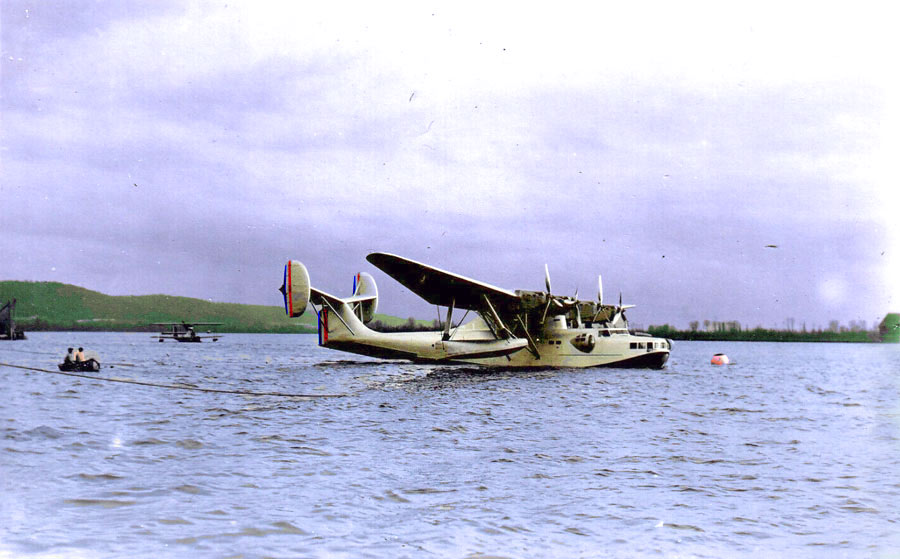
Un hydravion posé sur la Seine devant Caudebec-en-Caux
A seaplane landing on the Seine in front of Caudebec-en-Caux
|
Fernand Le Grand sait que le transfert de sa radio de Fécamp à Caudebec est indispensable pour se maintenir honorablement devant la concurrence parisienne. De plus en plus d'artistes se produisent en direct dans les studios et se plaignent de l'éloignement de Paris. Il est conscient de ce handicap : "Pour répondre aux nouvelles exigences des vedettes, nous devons nous rapprocher de la capitale.
Caudebec se trouve loin du chemin de fer
(1). Dans quelques années, grâce aux nouveaux moyens de transport, nos invités arriveront directement de Paris dans des hydravions qui se poseront sur la Seine."
(1) La gare la plus proche est à Yvetot (12 km) ou
à Barentin. Il y avait bien une petite gare à Caudebec-en-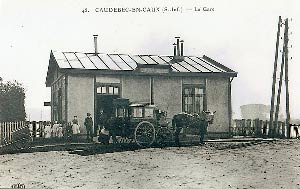 Caux
(< photo), terminus d'une ligne venant de Barentin. Caux
(< photo), terminus d'une ligne venant de Barentin.
Mais un seul convoi circulait quotidien-nement sur la ligne, l'essentiel des voyageurs était véhiculé par 5 allers et retours assurés par
autocar. Le train ne mettait pas moins de 2 heures pour se rendre de Barentin à Caudebec.
"Faîtes-nous préférer le train !" qu'ils disaient... |
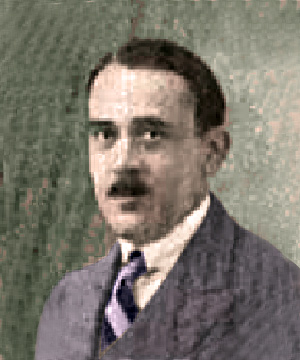 Fernand Le Grand knows that the transfer of his radio from Fécamp to Caudebec is essential to maintain itself honorably in front of the Parisian competition. Fernand Le Grand knows that the transfer of his radio from Fécamp to Caudebec is essential to maintain itself honorably in front of the Parisian competition.
More and more artists are performing live in the studios and complain about the distance from Paris.
He is aware of this handicap: "To meet the new demands of the stars, we have to get closer to the capital. Caudebec is far from the railroad.(1) In a few years, thanks to new means of transportation, our guests will arrive directly from Paris in seaplanes that will land on the Seine."
(1) The nearest railway station is in Yvetot (12 km) or Barentin. There was indeed a little station in Caudebec-en-Caux, terminus of a line coming from Barentin. But only one convoy circulated daily on the line, the majority of travelers were transported by coach. The train takes no less than 2 hours to get from Barentin to Caudebec. |
|
| |

Le "château" devenu aujourd'hui l'Hôtel de Ville de Caudebec-en-Caux
The "castle" now the City Hall of Caudebec-en-Caux

L'arrière du château
The back of the castle

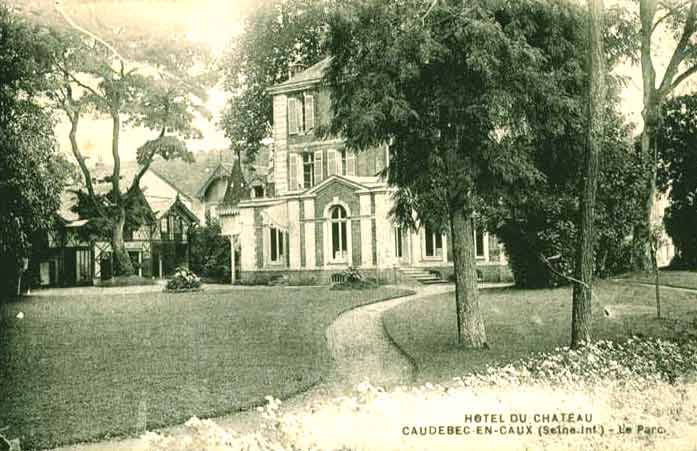
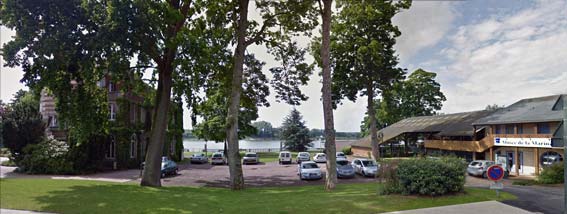
L'ancien parc du château est devenu parking. Au fond la Seine. Si les studios français étaient situés dans le château,
les studios anglais étaient installés dans des annexes à droite, démolies après la guerre pour laisser place au Musée de la Marine
The former castle garden became parking. Off the river Seine. If the French studios were located in the castle, the English studios
were installed in the annexes to the right that were demolished after the war to make way for a Navy Museum

Au fond du parc de nos jours, le Musée de la Marine de Caudebec. En 1938 et 1939, se tenaient ici
les studios destinés aux émissions en langue anglaise. Pas de photos hélas.
At the end of the park nowadays, the Marine Museum of Caudebec. In 1938 and 1939,
the studios for English language broadcasts were located here. Unfortunately no photos.
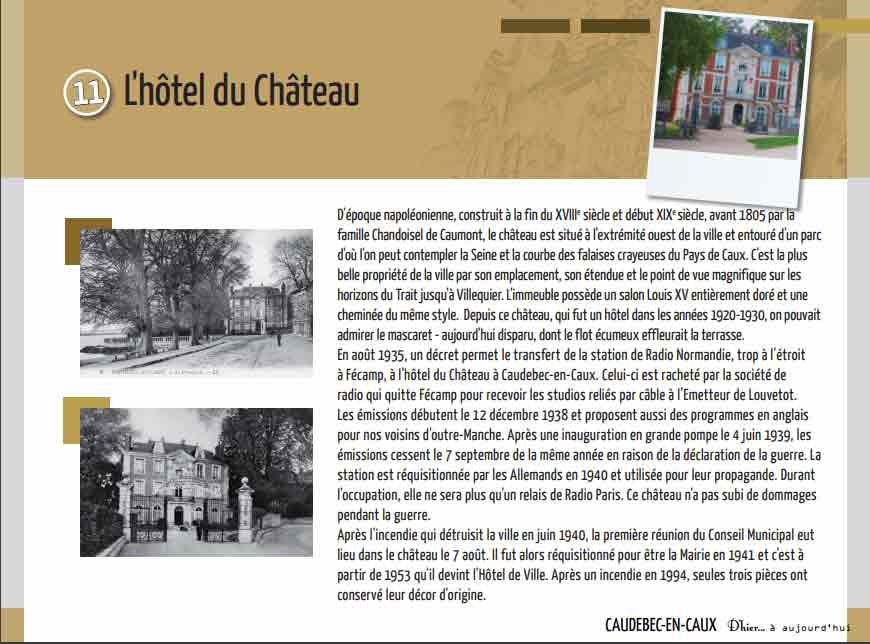
Extrait d'une brochure "Caudebec-en-Caux, d'hier et d'aujourd'hui"
https://www.rives-en-seine.fr/wp-content/uploads/2019/04/circuit-des-sages-FR-2.pdf
|
|
The Château Hotel
Dating from the Napoleonic era, built in the late 18th and early
19th centuries, before 1805 by the Chandoisel de Caumont family, the
château is located at the western edge of the town and surrounded by
a park from which one can contemplate the Seine and the curve of the
chalk cliffs of the Pays de Caux. It is the most beautiful property
in the town due to its location, its size, and the magnificent view
over the horizons of the Trait as far as Villequier. The building
has a fully gilded Louis XV salon and a fireplace in the same style.
From this château, which was a hotel in the 1920s and 1930s, one
could admire the tidal bore—now gone—whose foaming flow brushed
against the terrace. In August 1935, a decree permitted the transfer
of the Radio Normandie station, too cramped in Fécamp, to the
Château Hotel in Caudebec-en-Caux This was bought by the radio
company, which left Fécamp to receive the studios connected by cable
to the Louvetot transmitter. Broadcasts began on December 12, 1938,
and also offered programs in English for our neighbors across the
Channel. After a grand inauguration on June 4, 1939, broadcasts
ceased on September 7 of the same year due to the declaration of war.
The station was requisitioned by the Germans in 1940 and used for
their propaganda. During the occupation, it was only a relay for
Radio Paris. This castle suffered no damage during the war.
After the fire that destroyed the town in June 1940, the first
meeting of the Municipal Council was held in the castle on August 7.
It was then requisitioned to become the Town Hall in 1941 and became
the City Hall in 1953. After a fire in 1994, only three rooms
retained their original decor. |
CAUDEBEC-EN-CAUX Yesterday... to today
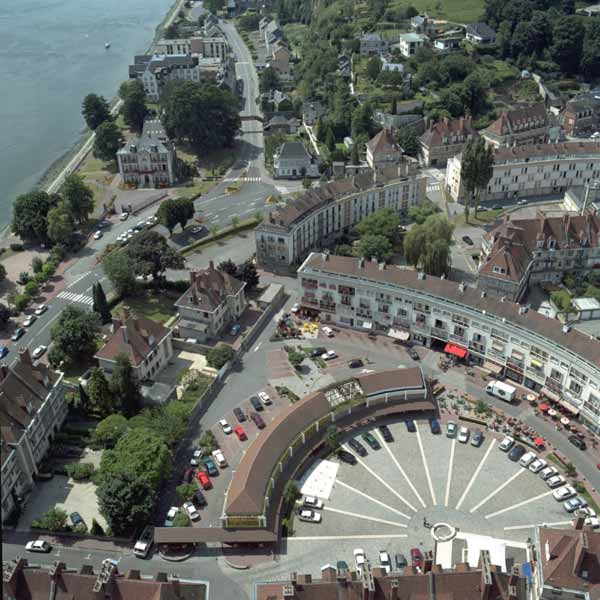
|
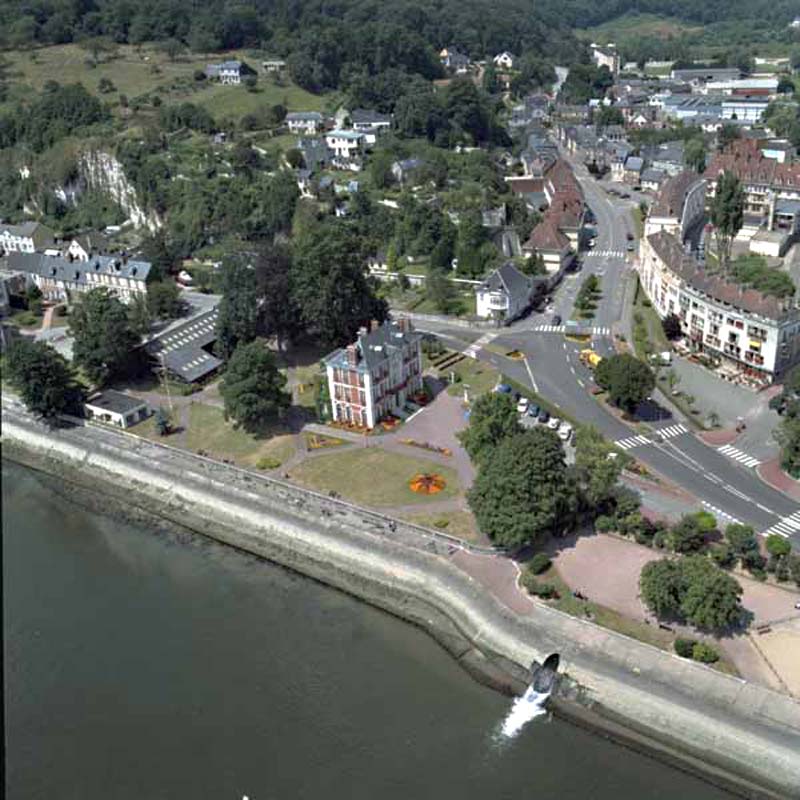
|
Vues aériennes de Caudebec-en-Caux et du "Château" au bord de la Seine. Avec l'évolution du temps, le parc semble s'être considérablement rapetissé. La route qui suit la Seine vers la gauche, conduit à Villequier où Victor Hugo a vécu.
Aerial views of Caudebec-en-Caux and the "Castle" on the banks of the Seine. With the passage of time, the park seems
to have shrunk considerably. The road that follows the Seine to the left leads to Villequier where the poet Victor Hugo lived. |
 |
Le poste actuel de Radio Normandie est tout à fait unique en son genre. M. Fernand Le Grand a voulu lui conserver son caractère régional normand aussi bien dans ses bâtiments modernes que dans la transformation d'un des plus jolis châteaux des bords de la Seine. Si le pylône antenne a dû être placé sur l'un des points les plus élevés et les plus dégagés de tout le pays de Caux, par contre le château (studios de Caudebec), dans la vallée, se trouve près de la route où passe le câble souterrain de communication longue distance. De plus, des usines d'aviation sont à proximité et des services d'hydravions remplaceront bientôt les autos et le chemin de fer.
Les techniciens, les artistes, les vedettes de toutes sortes pourront donc se déplacer dans le minimum de temps et apporter à la station leur précieux concours indispensable à la bonne marche et à l'intérêt des émissions. Les enregistrements de manifestations sportives, politiques, religieuses ou artistiques pourront être diffusés quelques heures après qu'elles auront eu lieu. Les câbles téléphoniques ne chômeront pas non plus. Les retransmissions devront être pour ainsi dire, parfaites, puisque le château est sur le parcours même des câbles de l'Administration des P.T.T.
Bref Caudebec-Louvetot est placé au cœur même de la Normandie, au point le plus central permettant d'assurer des émissions de la plus haute qualité et dans les meilleures conditions possibles. En 1938, l'Association des Auditeurs de Radio Normandie groupe plus de 32.000 adhérents et à répartir dans les sections suivantes : Abbeville, Amiens, Bayeux, Berck, Boulogne, Caen, Calais, Yvetot, Cherbourg, Trouville, Deauville, Dieppe, Dunkerque, Honfleur, Fécamp, Le Crotoy, Le Havre, Le Tréport, Rouen, St-Valéry-sur-Somme. |
The current Radio Normandie station is quite unique. Mr. Fernand Le Grand wanted to keep its regional Norman character both in its modern buildings and in the transformation of one of the prettiest châteaux on the banks of the Seine. If the aerial pylon must have been placed on one of the highest and most unobstructed points in the whole of Caux, on the other hand the castle (studios of Caudebec), in the valley, is located near the road where passes the underground long-distance communication cable. In addition, aviation factories are nearby, and seaplane services will soon replace cars and railroads.
Technicians, artists, stars of all kinds will therefore be able to travel in the minimum of time and provide the station with their invaluable assistance, which is essential for the smooth running and interest of the programs. Recordings of sporting, political, religious or artistic events may be broadcast a few hours after they have taken place. Telephone cables will not be idle either. The retransmissions will have to be, so to speak, perfect, since the castle is on the very route of the cables of the P.T.T.
In short, Caudebec-Louvetot is located in the very heart of Normandy, at the most central point to ensure broadcasts of the highest quality and under the best possible conditions. In 1938, the Association des Auditors de Radio Normandie had more than 32,000 members and were to be divided into the following sections: Abbeville, Amiens, Bayeux, Berck, Boulogne, Caen, Calais, Yvetot, Cherbourg, Trouville, Deauville, Dieppe, Dunkirk, Honfleur, Fécamp, Le Crotoy, Le Havre, Le Tréport, Rouen, St-Valéry-sur-Somme. |
|
12-13 décembre 1938
PREMIERS JOURS d'éMISSION DEPUIS CAUDEBEC & LOUVETOT sur 274 m

|
Programme du 8 janvier 1939
(français et anglais)
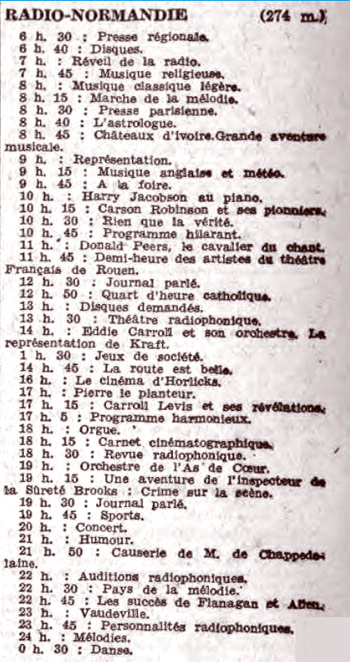
|
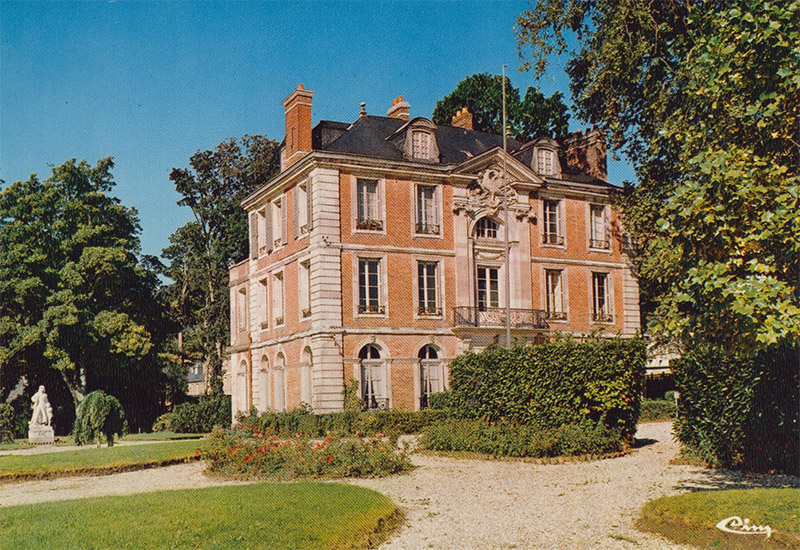
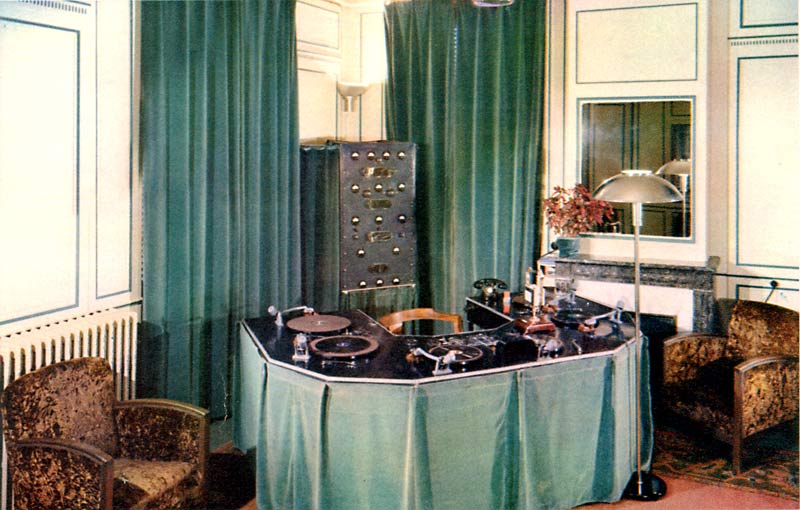
Dans le château, le studio "vert" pour les émissions en langue française
In the castle, the "green" studio for French-language programs
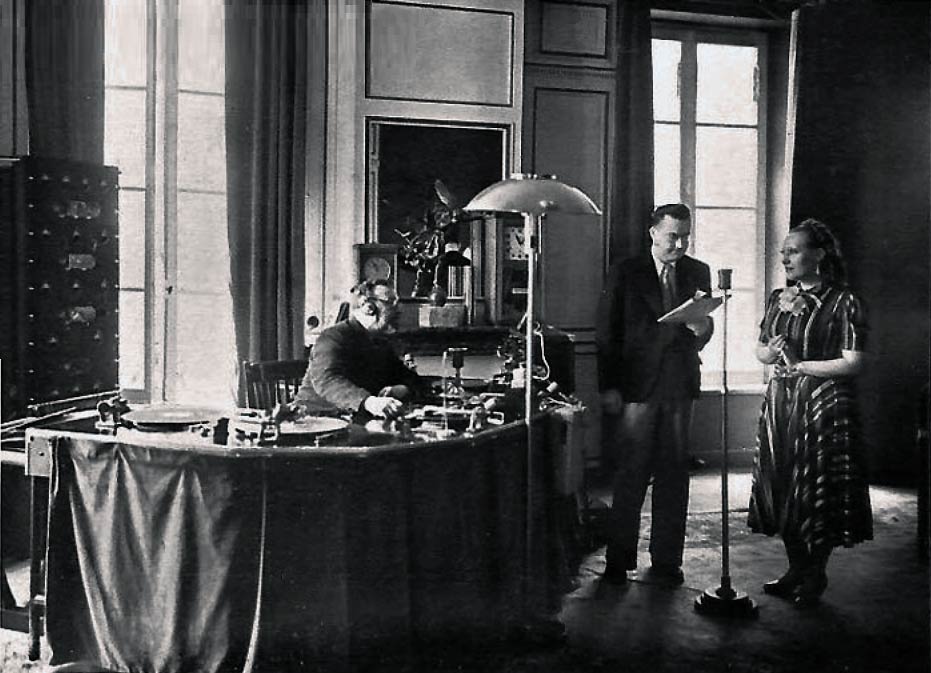
Enregistrement ou transmission en direct (?) d'une émission française. Oncle Roland est à la technique !
Recording or live broadcast (?) of a French program. Uncle Roland takes care of the technique !
Les émissions françaises étaient réalisées depuis le château. Les émissions anglaises venaient des dépendances au fond du parc. (hélas pas de photos) L'émetteur de Radio Normandie à Louvetot (6 km au nord de Caudebec sur le plateau) a diffusé alternativement durant quelques mois (du 12 décembre 1938 au 7-8 septembre 1939) les émissions réalisées à Caudebec tout au long de la journée et de la nuit dans les deux langues. La guerre a mis fin à ce rêve radiophonique... |
French broadcasts were made from the castle. The English broadcasts came from the outbuildings at the back of the park. (infortunately no photos) The Radio Normandie transmitter in Louvetot (6 km north of Caudebec on the plateau) broadcast alternately for a few months (from December 12, 1938 to September 7-8, 1939) the programs produced in Caudebec throughout the day and night in both languages. The war put an end to this radio dream... |
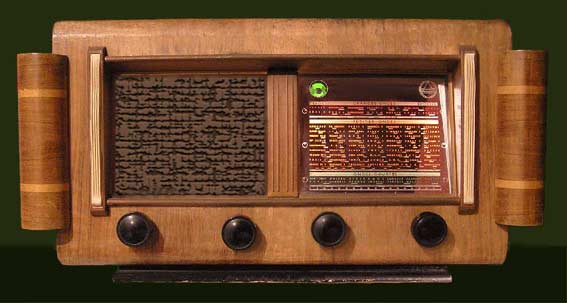
Récepteur de la fin des années 40 et son "œil magique"
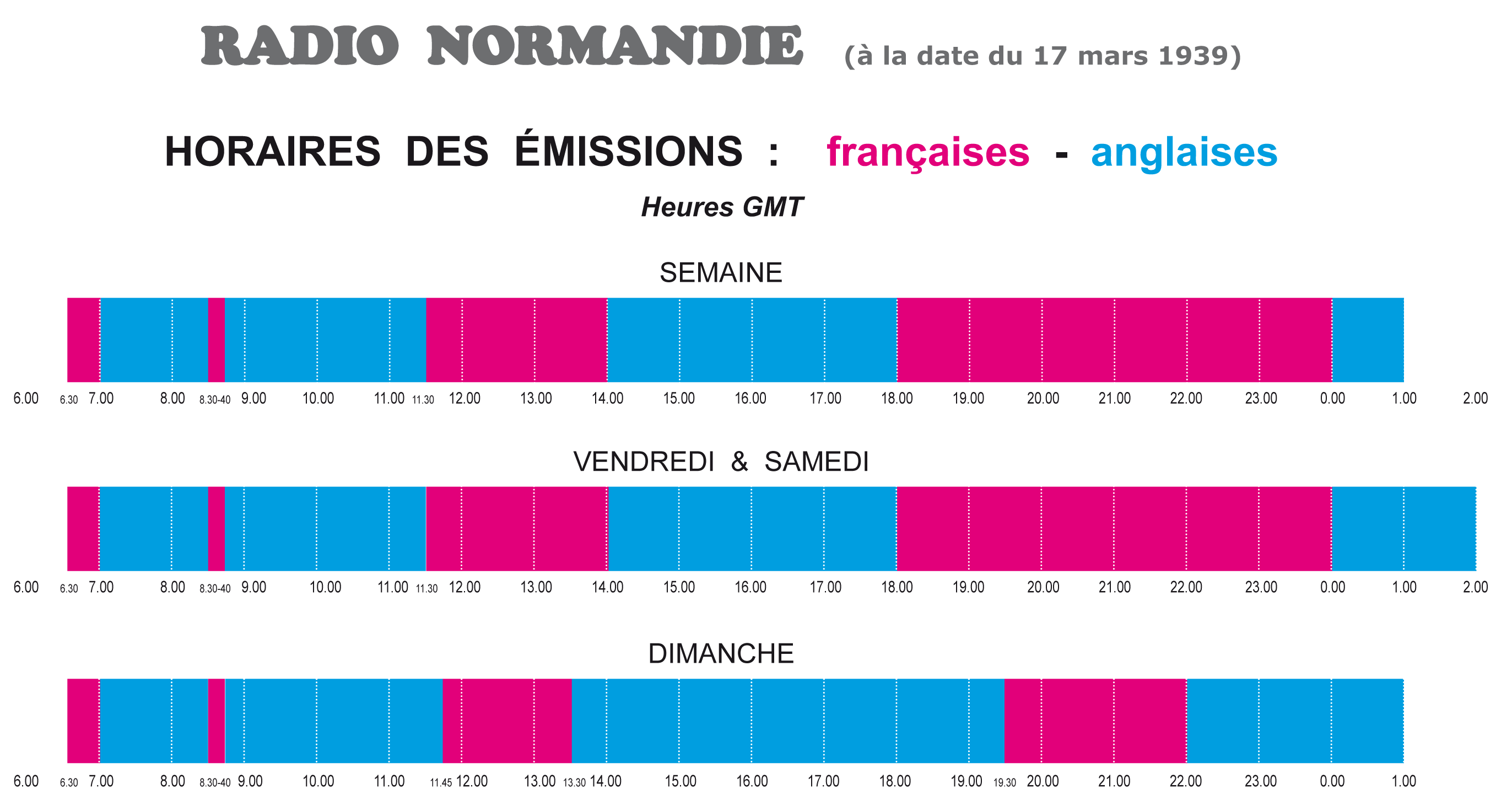
pink: French broadcasts blue: English broadcasts | 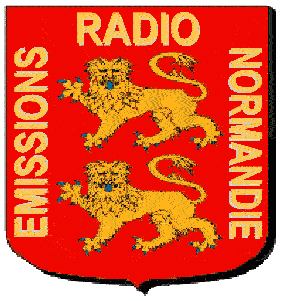
| 
| 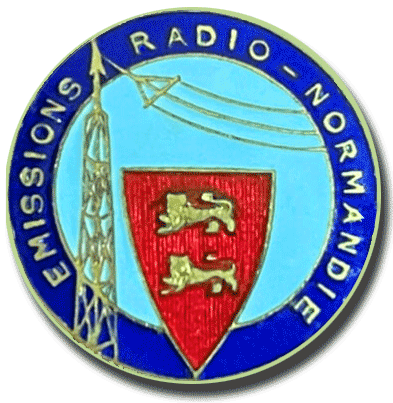
| 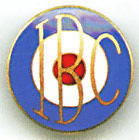
|
Horaires des émissions à la date du 17 mars 1939
Horaires des programmes français :
semaine 6.30 à 7.00 - 8.30 à 8.40 - 11.30 à 14.00 - 18.00 à 0.00
dimanche 6.30 à 7.00 - 8.30 à 8.40 - 11.45 à 13.30 - 19.30 à 22.00
Horaires des programmes anglais :
semaine 7.00 à 8.30 - 8.40 à 11.30 - 14.00 à 18.00 - 0.00 à 1.00
(jusqu'à 2.00 le vendredi et samedi)
dimanche 7.00 à 8.30 - 8.40 à 11.45 - 13.30 à 19.30 - 22.00 à 1.00
(Par semaine : 60 h françaises et 71 h 35' anglaises)
|
|
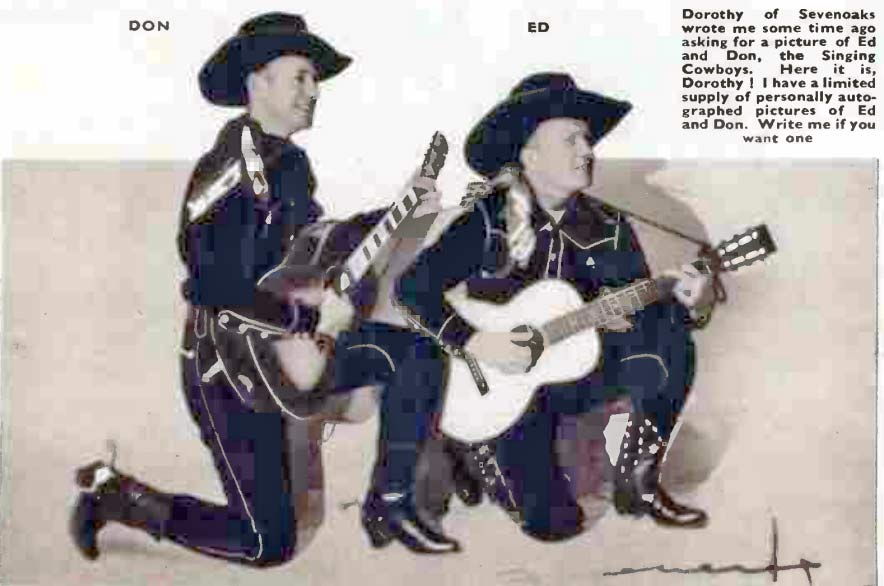
< Ed et Don, les Cow-boys chantants
tous les après-midi à 15 h 30,
depuis Caudebec
< Ed and Don, the Singing Cowboys
every afternoon at 3:30 p.m., reside in
Caudebec
(Radio Pictorial 8.09.1939)
|
La dernière émission en anglais est diffusée le jeudi 7 septembre 1939 (fin à 1.00 le 8.09.1939
Détails du programme anglais avec le nom des sponsors pour chaque émission de 15 mn : "présenté par..."
The last English broadcast was on Thursday September 7, 1939 (end at 1.00 on 8.09.1939)
English programme with the name of the sponsors for each 15-minute program: "presented by..."

|
La dernière émission "Melody at Midnight" était patronnée (sponsorisée) par le laxatif "Bile Beans"
The very last show "Melody at Midnight" was sponsored by the laxative "Bile Beans"

Bile Beans était à la fois un laxatif et un tonique. Le produit contiendrait des substances extraites d'un légume jusqu'alors inconnu !
Bile Beans was a laxative and tonic. The product supposedly contained substances extracted from a hitherto unknown vegetable !
|
Extinction de l'émetteur à 1.00 (matin) le vendredi 8 septembre 1939. L'émetteur de Louvetot est réquisitionné le jour-même par le gouvernement français pour "raisons de défense nationale" ! Ceci était un prétexte pour s'emparer des installations car Radio Normandie a été la seule station privée à être réquisitionnée par les autorités françaises
The transmitter was shut down at 1.00 am on Friday 8 September 1939. The Louvetot transmitter was requisitioned the same day by the French government for "national defence reasons"! This was a pretext to seize the facilities because Radio Normandie was the only private station to be requisitioned by the French authorities.
|
7 septembre 1939
Conducteur du jeudi 7 septembre 1939
La dernière journée d'émission de Radio Normandie depuis Louvetot et Caudebec
The last day of broadcast of Radio Normandie from Louvetot and Caudebec
(en blanc : émissions françaises - in green : english broadcasts)
- - - - - - - - - |
6 h. 30 : Après « Les vieux pommiers de Normandie », réveil en musique militaire.
6 h. 50 : Revue de la presse régionale du « Journal de Rouen ».
7 h. 00 : Culture physique.
7 h. 15 : La route est belle. Météo.
7 h. 30 : Musique militaire.
8 h. 00 : Musique diverse.
8 h. 15 : Ciné-magazine.
8 h. 30 : Revue de la presse parisienne depuis le studio de « ParisSoir ».
8 h. 40 : L'astrologue de « Radio-Normandie » vous parle.
8 h. 45 : Musique anglaise.
9 h. 00 : Variétés.
9 h. 15 : Conseils pour bien vous porter.
9 h. 20 : Aux sons des banjos.
9 h. 30 : Harold Ramsay à l'orgue.
9 h. 45 : Teddy Randall et son orchestre.
10 h. 00 : Retransmission depuis la basilique de Lisieux d'une audition de musique religieuse.
11 h. 00 : Enregistrement avec Ninon Vallin et Georges Thil.
11 h. 30 : Extraits d'opérettes.
12 h. 00 : Concert des auditeurs de R.N.
12 h. 30 : Journal parlé organisé et réalisé par «Paris-Soir».
13 h. 00 : Matinée enfantine.
14 h. 00 : Disques demandés par les auditeurs.
14 h. 15 : Les aventures de Mr Keen, détective.
14 h. 30 : Concert par l'orchestre de l'Armée du Salut.
15 h. 00 : Roman de l'obscure épouse d'une célébrité.
15 h. 15 : Roman de Stella Dallas.
15 h. 30 : ED et DON, les fameux cow-boys, dans leur répertoire.
15 h. 45 : Le miroir musical.
16 h. 00 : Vedettes du micro, avec Wilfrid Thomas.
16 h. 15 : Cantiques anglais.
16 h. 30 : La musique des étoiles.
16 h. 45 : Le roman de Marmaduke, par Brown et Mathilde.
17 h. 00 : Les aventures d'un reporter du crime.
17 h. 15 : Le tour du monde, avec Sandy Powell.
17 h. 20 : Les aventures de Vic Samson.
17 h. 45 : Les courses de lévriers.
18 h. 01 : Cours du marché de la Villette.
18 h. 05 : Retransmission depuis Lisieux d'un concert de musique religieuse.
18 h. 50 : La minute du « Journal de Rouen ».
19 h. 00 : Enregistrement de Jean Tranchant et Max Gilbert.
19 h. 45 : Bach et Henri Laverne.
19 h. 55 : Journal parlé réalisé par «Paris Soir ».
20 h. 10 : Concert des auditeurs de R.N. Variétés.
21 h. 00 : « Les contes d'Hoffmann », d'Offenbach. Retransmission depuis le casino de Fécamp.
24 h. 00 : Variétés.
0 h. 30 : Musique de danse anglaise.
1 h. 00 : Clôture de la station.
|
"Radio Normandie avait fonctionné ce jour-là pendant dix-huit heures et trente minutes, mais c'était pour la dernière fois. Sa voix s'était tue, car la guerre était là. Jamais plus les auditeurs français et étrangers si sympathiquement attachés à ses programmes, porteurs de joie dans leurs foyers, ne l'entendraient. Ces programmes disparaîtraient à tout jamais des périodiques qui prêtaient si aimablement leurs colonnes, tels le Haut-Parleur, Mon Programme, l'hebdomadaire belge "Les Charmes du Foyer", et la semaine allemande Funk Stunde, etc, et les quotidiens de grande presse qui avaient consacré à RN tant d'articles élogieux. Le décret du 3 septembre 1939 réquisitionnant la station était tombé comme un couperet implacable. Le poste d'émission devenait un relais de la chaîne d'état. Le fondateur devait décéder en 1953. Avec sa persévérance habituelle, il poursuivait toujours son rêve inachevé avec l'espérance au cœur de pouvoir le reprendre un jour.
Hélas ! Nous n'entendrons plus, chaque jour que Dieu fait, sortir des maisons ou s'égrenant au fond de quelque village, les airs qui nous étaient si chers : Les vieux pommiers, J'irai revoir ma Normandie, Bonsoir chers amis ou Bon anniversaire.
"Cela nous manque", m'a-t-on dit parfois, mais nous pouvons, nous aussi, rêver, comme l'homme à qui nous devions ces douces heures du passé et qui nous faisaient marcher comme en "un rêve étoilé".
Extrait du livre "Allo ! Allo ! Ici Radio Normandie" de M. Jean Lemaître - Président des Amis du Vieux Fécamp - Eds L Durand 1984. |
"Radio Normandie had operated that day for eighteen hours and thirty minutes, but it was for the last time. Its voice had fallen silent, because the war was here. Never again would the French and foreign listeners so sympathetically attached to its programs, bringing joy to their homes, would never hear it. These programs would disappear forever from the periodicals which so kindly lent their columns, such as Le Haut-Parleur, Mon Program, the Belgian weekly "Les Charmes du Foyer". , and the German week Funk Stunde, etc., and the major press dailies which had devoted so many laudatory articles to RN. The decree of September 3, 1939 requisitioning the station had fallen like an implacable ax. relay of the state chain The founder was to die in 1953. With his usual perseverance, he always pursued his unfinished dream with the hope in his heart of being able to resume it one day.
Alas! We will no longer hear, every day that God makes, leaving the houses or playing in the depths of some village, the tunes that were so dear to us: The old apple trees, I will see my Normandy again, Good evening dear friends or Happy birthday .
“We miss it”, I have sometimes been told, but we too can dream, like the man to whom we owed these sweet hours of the past and who made us walk as if in “a starry dream” . |
|
|
|
|
|
La chute soudaine de Radio Normandie le 8 septembre 1939
Peu de temps après que Radio Normandie eut transféré ses studios à Caudebec, et au plus fort de sa prospérité, la station connut un destin particulier : elle fut nationalisée (réquisitionnée le 8 septembre 1939) par le gouvernement français comme mesure d'urgence de guerre, Fernand Le Grand cessa d'avoir tout contrôle sur elle et elle fut désormais utilisée pour transmettre des émissions en langues étrangères vers l'Europe de l'Est et l'Europe centrale.
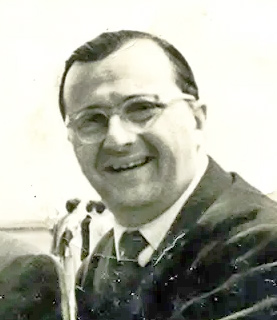 Cette nationalisation, qui eut lieu en septembre 1939, fut la seule mesure de ce genre à l'égard d'une station de radio privée française, et René Duval (cf son livre) indique qu'elle fut prise non par nécessité mais à cause d'une rancune de la part d'un ancien associé de Le Grand, Max Brusset*
(< photo) avec qui Le Grand avait rompu à cause de certaines transactions commerciales "en coulisses" que le premier avait eues avec l'IBC. Brusset devint plus tard l'assistant d'un ministre (Georges Mandel) et, selon René Duval, persuada le ministre de nationaliser la station. Cette nationalisation, qui eut lieu en septembre 1939, fut la seule mesure de ce genre à l'égard d'une station de radio privée française, et René Duval (cf son livre) indique qu'elle fut prise non par nécessité mais à cause d'une rancune de la part d'un ancien associé de Le Grand, Max Brusset*
(< photo) avec qui Le Grand avait rompu à cause de certaines transactions commerciales "en coulisses" que le premier avait eues avec l'IBC. Brusset devint plus tard l'assistant d'un ministre (Georges Mandel) et, selon René Duval, persuada le ministre de nationaliser la station.
DONALD R. BROWNE - Extrait de "Radio Normandie et le défi lancé par l'IBC au monopole de la BBC" (< cliquer sur le lien)
* cf les manigances de Brusset aux paragraphes "Radio International" plus bas
The
Sudden Fall of Radio Normandie
on September 8, 1939
Shortly after Radio Normandie moved its studios to Caudebec, and at the
height of its prosperity, the station suffered a peculiar fate: it was
nationalized (requisitioned on September 8, 1939) by the French
government as a wartime emergency measure. Fernand Le Grand ceased to
have any control over it, and it was henceforth used to transmit
foreign-language broadcasts to Eastern and Central Europe.
This nationalization, which took place in September 1939, was the only
measure of its kind against a French private radio station, and René
Duval (see his book) indicates that it was taken not out of necessity
but because of a grudge on the part of a former associate of Le Grand,
Max Brusset
(photo above) with whom Le Grand had broken off over certain "behind-the-scenes"
business dealings the former had with the IBC. Brusset later became an
assistant to a minister (Georges Mandel) and, according to René Duval,
persuaded the minister to nationalize the station.
DONALD R. BROWNE - Excerpt from "Radio Normandie and the IBC's
Challenge to the BBC Monopoly"
(Photo de Max Brusset - 1958) |
| |
|
Pendant la guerre, M. Fernand Legrand, par le canal de M. Briand avait vendu à l’Agence Havas, présidée par Léon Régnier, une grande partie de ses actions. De ce fait, la majorité du poste (Radio Normandie à Louvetot) appartenait à l’Agence Havas sauf pour 25 % qui restaient la propriété de personnes privées. |
During the war, Mr. Fernand Legrand, through Mr. Briand, had sold a large portion of his shares to the Havas Agency, chaired by Léon Régnier. As a result, the majority of the station (Radio Normandie in Louvetot) belonged to the Havas Agency, except for 25%, which remained privately owned. |
|
| |
|
|











































 Au cours de l'été 1937, Maurice Farquharson (contrôleur - relations publiques à la BBC), en vacances en Normandie, constate l'ampleur des investissements rendus possibles par la montée en puissance financière des radios commerciales sur le continent. En traversant la petite ville de Caudebec-en-Caux, il tombe sur le nouveau siège, pas encore opérationnel, de Radio Normandie. À cette époque, la station fonctionne encore dans ses studios exigus de Fécamp. En revanche, les nouveaux locaux dévoilent une grande opulence, puisqu'il s'agit d'un très beau petit château d'époque, peut-être du début du XVIIIe siècle, situé dans un délicieux jardin au bord de la Seine. Farquharson a pu accéder au bâtiment, sans doute parce qu'une grande partie est ouverte au public, notamment un restaurant. Les studios, a-t-il observé, se trouvent aux premier et dernier étages, et la seule indication extérieure de la destination du bâtiment en tant que centre de radiodiffusion est fournie par les mots "Radio Normandie" en lettres dorées sur le portail d'entrée. Il a recommandé le restaurant comme étant très bon - presque certainement le meilleur de l'endroit,
Au cours de l'été 1937, Maurice Farquharson (contrôleur - relations publiques à la BBC), en vacances en Normandie, constate l'ampleur des investissements rendus possibles par la montée en puissance financière des radios commerciales sur le continent. En traversant la petite ville de Caudebec-en-Caux, il tombe sur le nouveau siège, pas encore opérationnel, de Radio Normandie. À cette époque, la station fonctionne encore dans ses studios exigus de Fécamp. En revanche, les nouveaux locaux dévoilent une grande opulence, puisqu'il s'agit d'un très beau petit château d'époque, peut-être du début du XVIIIe siècle, situé dans un délicieux jardin au bord de la Seine. Farquharson a pu accéder au bâtiment, sans doute parce qu'une grande partie est ouverte au public, notamment un restaurant. Les studios, a-t-il observé, se trouvent aux premier et dernier étages, et la seule indication extérieure de la destination du bâtiment en tant que centre de radiodiffusion est fournie par les mots "Radio Normandie" en lettres dorées sur le portail d'entrée. Il a recommandé le restaurant comme étant très bon - presque certainement le meilleur de l'endroit,
 That summer of 1937, Maurice Farquharson (BBC controller and public relations dept), on holiday in Normandy, had received a graphic illustration of the extent of investment that had become possible as Continental Commercial Radio gained in financial stature. Traveling through the small town of Caudebec-en-Caux, he came across the new headquarters, not yet opened, of Radio Normandy. At this point, the station was still operating from its original cramped studios in Fecamp. The new premises represented considerable opulence in contrast, consisting as they did of "an extremely beautiful little period chateau, perhaps early eighteenth century, situated in a delightful garden on the river bank of the Seine. "Farquharson was able to gain access to the building, presumably because much of it was open to the public, including a restaurant. The studios, he observed, were on the "first and upper storeys", and "the only outward indication of the building's purpose as a broadcasting center is provided by the words "Radio Normandie" in gilt letters on the entrance gateway. " He was able to recommend the restaurant as "very good - almost certainly the best in the place", and this, together with the fact that Caudebec was noted as a beauty spot, very popular with visitors "will no doubt in themselves bring the company a certain amount of goodwill. " It was only when he explored further that he realized that the Chateau premises were only for the French native broadcasts...
That summer of 1937, Maurice Farquharson (BBC controller and public relations dept), on holiday in Normandy, had received a graphic illustration of the extent of investment that had become possible as Continental Commercial Radio gained in financial stature. Traveling through the small town of Caudebec-en-Caux, he came across the new headquarters, not yet opened, of Radio Normandy. At this point, the station was still operating from its original cramped studios in Fecamp. The new premises represented considerable opulence in contrast, consisting as they did of "an extremely beautiful little period chateau, perhaps early eighteenth century, situated in a delightful garden on the river bank of the Seine. "Farquharson was able to gain access to the building, presumably because much of it was open to the public, including a restaurant. The studios, he observed, were on the "first and upper storeys", and "the only outward indication of the building's purpose as a broadcasting center is provided by the words "Radio Normandie" in gilt letters on the entrance gateway. " He was able to recommend the restaurant as "very good - almost certainly the best in the place", and this, together with the fact that Caudebec was noted as a beauty spot, very popular with visitors "will no doubt in themselves bring the company a certain amount of goodwill. " It was only when he explored further that he realized that the Chateau premises were only for the French native broadcasts... 


 Caux
(< photo), terminus d'une ligne venant de Barentin.
Caux
(< photo), terminus d'une ligne venant de Barentin.  Fernand Le Grand knows that the transfer of his radio from Fécamp to Caudebec is essential to maintain itself honorably in front of the Parisian competition.
Fernand Le Grand knows that the transfer of his radio from Fécamp to Caudebec is essential to maintain itself honorably in front of the Parisian competition. 


















 Cette nationalisation, qui eut lieu en septembre 1939, fut la seule mesure de ce genre à l'égard d'une station de radio privée française, et René Duval (cf son livre) indique qu'elle fut prise non par nécessité mais à cause d'une rancune de la part d'un ancien associé de Le Grand, Max Brusset*
(< photo) avec qui Le Grand avait rompu à cause de certaines transactions commerciales "en coulisses" que le premier avait eues avec l'IBC. Brusset devint plus tard l'assistant d'un ministre (Georges Mandel) et, selon René Duval, persuada le ministre de nationaliser la station.
Cette nationalisation, qui eut lieu en septembre 1939, fut la seule mesure de ce genre à l'égard d'une station de radio privée française, et René Duval (cf son livre) indique qu'elle fut prise non par nécessité mais à cause d'une rancune de la part d'un ancien associé de Le Grand, Max Brusset*
(< photo) avec qui Le Grand avait rompu à cause de certaines transactions commerciales "en coulisses" que le premier avait eues avec l'IBC. Brusset devint plus tard l'assistant d'un ministre (Georges Mandel) et, selon René Duval, persuada le ministre de nationaliser la station.